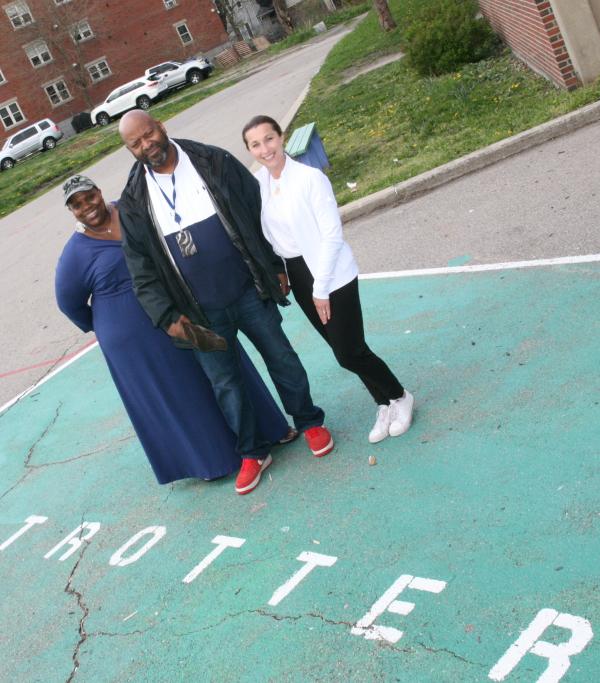April 26, 2023

Trotter School teacher Brianne Gore, Community Liaison Walter Apperwhite, and Principal Sarita Thomas on the Trotter playground with its wide-open space. Seth Daniel photo
The Trotter K-6 Elementary School playground on Humboldt Avenue has no shortage of open space, but the problem is there’s nothing happening there.
That will soon change, thanks to a $1 million Community Investment Act grant that was announced last week that will be used to transform a play space now consisting of paved surfaces, a small track, and a few patches of grass into a fully programmed facility with play structures, trees, soccer goals, swings, climbing gyms, and a basketball hoop.
Boston voters approved the Community Preservation Act (CPA) in 2016. It is funded by a one percent property tax-based surcharge on residential and business property tax bills that took effect in July 2017 and by matching funds from the Massachusetts Community Preservation Trust Fund.
The grant for the Trotter School was just part of a $40 million allotment for 56 projects that were announced by the local CPA Committee and approved by the City Council and Mayor Wu. The Trotter School allotment was among a number of other projects funded by the CPA in Dorchester and Mattapan.
At the school, the news was cause for celebration this week, according to principal Sarita Thomas.
“The kids want to come outside, and they want to socialize, but once they’re out here, it’s just here,” she said. “If they don’t have the imagination to make up games, they end up just sitting there. They will often play tag, but that sometimes ends up in someone getting hurt. They need something structured. If they want to climb and jump and run, they need something to do that on.”
Brianne Gore, a BPS teacher who lives in Dorchester, has been a leading voice for a new play space.
“When I walk down the stairs, I can see that huge open space, and every day I came down those stairs, I just want to see kids playing out there on a structure. … and interact socially and do so in a positive outdoor environment. When they can go outside and play on a climbing structure or with sensory-friendly equipment, it motivates them. It’s really going to transform this space.”
Along with Trotter community liaison Walter Apperwhite, Thomas and Gore began the search for funding for improvements. Though Boston Public Schools officials told them there wasn’t money in the budget for a new schoolyard, they did point them to the CPA. That started things in motion and resulted in a rough design for the schoolyard, $1 million in funding, and a potential start date of Spring 2024.
“You’ve gone from a case where Ms. Gore said, ‘Wouldn’t it be nice if we could…’ to identifying a funding source to applying for that funding source and now we’re talking about it being done,” said Apperwhite.
Not lost on anyone in the group is the fact that seeing the improvements through a lens of equity is what sparked the action at the Trotter. While other schoolyards might have been done three or four times over, the Trotter – located on the Dorchester/Roxbury line – has not been significantly improved since it was built in 1969.
“That’s what happens when you open up the lens of equity and teachers begin to question why our kids don’t get the same things as other kids,” said Thomas.
While other schools bus a lot of their pupils to their schools, many of the Trotter students live within walking distance, which means the new schoolyard will become an amenity for the neighborhood beyond school hours.
The schoolyard renovation is expected to be completed in September 2024, which coincides with the Trotter moving to the status of a full-inclusion school. So the new schoolyard will be equipped with structures friendly to students with special needs, they said.



